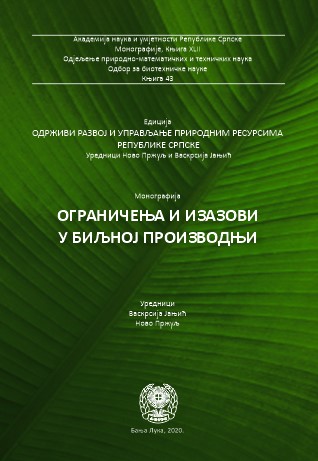Toxicological and ecotoxocological characteristics of pesticides important for their sustainable use
DOI:
https://doi.org/10.7251/EORU2003425MKeywords:
Pesticides, sustainable use of pesticides, toxicology and ecotoxicology of pesticidesAbstract
Modern concept of reducing the risk of pesticide use is based on the concept of sustainable use of pesticides. The concept of sustainable use of pesticides presents the range of professional rules, acts, skills of the pesticides use with the aim to promote the plant protection with decreased usage of pesticides, providing, whenever it is possible, advantage to non-chemical methods of plant protection. The most important part of sustainable pesticide usage is integrated plant protection. Integrated plant protection implies the application and integration of all available methods of plant protection which prevent the development of population of the harmful organisms above the level of harmfulness, considering that the usage of means for plant protection is at the level which is economically and ecologically justified. Risks for the human health and the environment is decreased or at least reduced to the minimum by the concept of pesticide application according to the integrated plant protection. Pesticides have certain potential to cause damage effect if people and the other organisms are exposed at the certain conditions and amount. Modern toxicology is directed to determine the safe dose, meaning the dose without the harmful effect as well as finding out the way of safe pesticide use. Considering the modern toxicology, two important terms are hazard and risk. Hazard is the intrinsic characteristic of the chemicals to cause the harmful effect at the defined conditions of the exposition. Risk is probability of manifestation of the harmful effect at the certain conditions of the exposition. The harmful effects of pesticides on humans mostly depend on the pesticides’ own toxicity but on the human’s exposure as well. The exposure of people to pesticides can appear at the working place. Farmers can be exposed to pesticides during the work in the open field and protected space, while the significant exposure can appear with workers in the pesticide industry as well as with workers who deal with jobs of deratization and disinsection and with workers in pesticides wholesale and retail. Estimation of the exposure of the agricultural workers is complex. Professional users are mostly exposed but the exposure is episodic. The particular problem is estimation of the exposure of the field workers and their householders as well. Therefore, while estimating the people’s exposure to pesticides in theresidential buildings, the remains of the pesticides in water, food, dust and air in and around the house is considered. Increased amounts of the pesticides in the house dust are related to exposure which depends on the distance between houses and the pesticide-treated fields, exposure in the house due to the fact that one or two householder work in the agriculture and larger use of pesticides in the residential buildings for treating different insects in the house or yard. Pesticides, besides their negative effects on people’s health, can have harmful effect on the environment, meaning that they can contaminate surface and underground water, soil and air, and to have toxic effects onto non-target organisms. There is a large number of documented papers where is proved that use of pesticides has great consequences onto the population of autochthonous wild animals. Integrated plant protection and sustainable use of pesticides cannot be only a declarative determinant. A wide range of steps have to be undertaken to enable their use in practice. Future imposes huge professional challenges related to the use of pesticides. The need to fulfill the different, sometimes even opposite demands is often imposed. On one side it is demanded to provide pesticides efficiency in protection from the harmful organisms and on the other side sustainable use and decreasing the risk for people and environment. Development of the new pesticides with the new ways of action and improved safety profiles and application of the alternative systems of plant production which will be less dependent on the pesticides could reduce the exposure to pesticides and side effects on people. The use of appropriate and well maintained equipment for pesticide use, while taking all protection measures at all stages of pesticides handling, can reduce the exposure to pesticides. Implementing the concept of sustainable use of pesticides is difficult, but for now it is the only promising way to ensure the protection of people, the environment and the production of healthy food.
